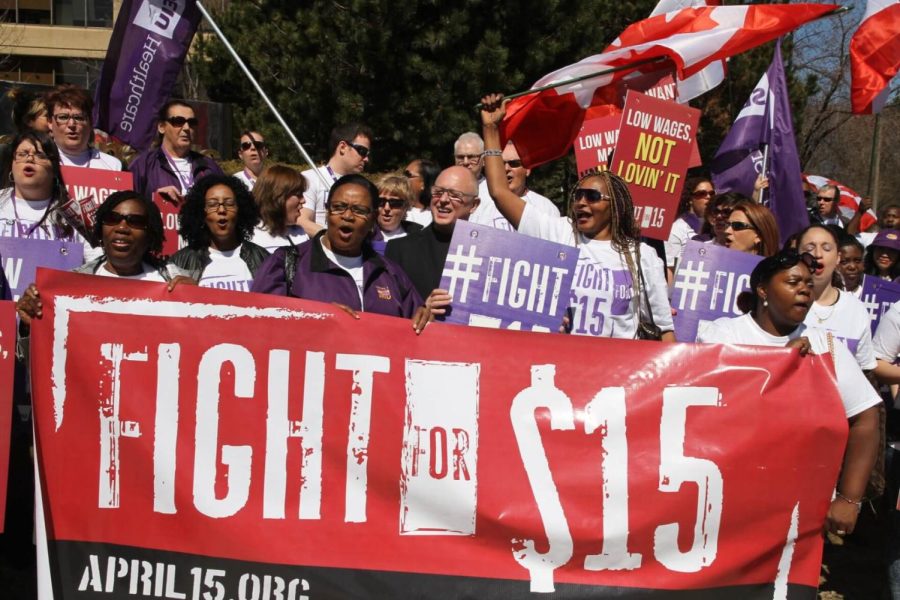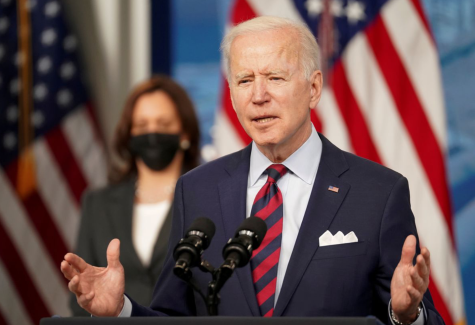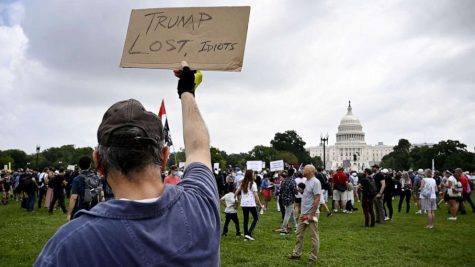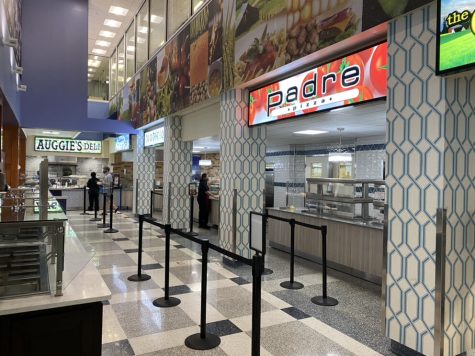Raising PA’s Minimum Wage Will Benefit Philly’s Working Class and Small Businesses
Courtesy of OFL Communications Department/Flikr
Protesters across the counrty advocate for an increased minimum wage of $15.
March 3, 2021
Amid negotiations for President Joe Biden’s $1.9 trillion stimulus proposal, some Democrats have encouraged raising the federal minimum wage from its current paltry rate of $7.25 per hour to $15. While this proposal is in jeopardy due to the rejection of conservative Democrats – namely Senators Joe Manchin (D-WV) and Kyrsten Sinema (D-AZ) – President Biden has suggested that he will fight for its passage at a later date.
Much ink has been spilled on the purported benefits and drawbacks of proposed minimum wage hikes. While they have been adopted in several states and cities, Philadelphia has had its efforts to raise the minimum wage frozen by intransigent state legislators. Worries about the effects of such a significant increase were understandable five years ago when major cities were just beginning to roll out their wage hikes. However, after years of studying the data from cities around the country, it’s increasingly clear that Philadelphia’s battered working class could benefit majorly from a federal minimum wage increase.
A momentary glance at Philadelphia would show a city on the upswing. After years of deindustrialization and an exodus of wealth and population to the suburbs, the city experienced what appears on the surface to be a remarkable rebound following the Great Recession. The city’s population has grown every year since 2008, and the city has experienced a decade of historic job growth, with over 55,000 new jobs added to the economy.
At the same time, a stunning 26% of Philadelphians live in poverty – a number that’s remained virtually unchanged for more than a decade and will likely rise amid the fallout of COVID-19. And while the city’s unemployment rate hit an all-time low of just over 4% in 2019, large-scale employment did basically nothing to curb the city’s poverty rate, which is the highest of the U.S.’s ten largest cities.
That a city could make such strides in job creation without making a dent in poverty seems unthinkable. But the type of job growth Philadelphia has experienced provides some answers. According to a 2019 report from the Center City District Foundation, 60.5% of the jobs created in Philadelphia between 2009 and 2018 were in sectors paying $35,000 or less on average, such as food service, retail, hospitality, administrative support and home health care. On the one hand, this growth in entry-level jobs allows for greater employment in a city where only 29% of residents have a bachelor’s degree. But what good is job growth if the jobs themselves pay poverty wages?
Raising the minimum wage to $15 per hour has the potential to provide a more dignified standard of living to Philadelphia’s working class. One estimate from the city’s Community Survey Data estimates that an increase to $15 would immediately lift the wages of 77,000 workers within the city and more than a quarter of a million residents by 2024.
And while those are merely projections, cities around the country – including Chicago, Washington, Oakland, San Jose, Seattle and San Francisco – have seen remarkable success with minimum wages over $10 on the way to $15. According to labor economist Sylvia Allegretto, who authored a study on the minimum wage and employment at Berkeley’s Center of Wage and Employment Dynamics, “we haven’t seen any significant employment losses due to these minimum wage policies, but we do see positive and statistically significant earnings effects.”
Meanwhile, a study from the University of Washington found that Seattle’s wage of $13 (which has since increased to $16.39 for companies with more than 500 employees) led to “significantly more rapid hourly wage growth” for those already employed at the low end of the wage scale, while those whose hours were cut had those losses offset by the increased wages for their time on the job.
Fears about unemployment did not bear themselves out either. In fact, restaurant and bar jobs feared to be most at risk due to wage increases actually increased after wages went up. Many cities reached $15 an hour or higher this year. And while they have not been at that level for long enough to gather data on the effects (and the pandemic has made it difficult to assess what the effects would be in normal economic conditions), data about previous wage increases around the country shows its strong potential.
Increasing the minimum wage to $15 in Philadelphia could raise wages for nearly half the workforce. According to a study by the Pew Charitable Trusts, around 40% of Philadelphia residents make less than $15 per hour, and around 17% make between $7.25 (the federal minimum wage) and $9.50 per hour.
This reality is allowed to persist because, unlike many other cities of comparable size that have raised their wages in recent years, Philadelphia’s minimum wage has remained locked at the federal level of $7.25 per hour. This is not for lack of ardor on the part of Philadelphia lawmakers, who passed a $15 minimum wage for city contractors and approved a referendum to extend that wage to all residents, nor is it for lack of support among Philadelphia voters, 82% of whom voted “yes.”
Philadelphia’s effort to raise wages has been hobbled by a 2006 state law prohibiting it from doing so without support from the state government, which is controlled by Republicans in both houses of the legislature. Republicans in the PA Senate broadly signed onto a bill that would have raised the state’s minimum to $9.50 by 2022 (which would leave minimum wage workers below the poverty line), but Republicans in the House have sat on the bill for over a year and are still yet to vote on it.
Despite strong evidence contradicting their fears, Republicans in the PA House have brought out some time-worn free-market canards to justify a vote against a well overdue wage increase for Pennsylvania. For instance, Rep. Tom Polinchock (Bucks County) called the increase a “trap” and said that “when you raise the minimum wage, you’re going to have companies that are going to be having labor costs increase, so you’re losing more of those jobs.” Business groups, such as the National Federation of Independent Businesses, have also lobbied hard against the increase. It’s difficult to imagine Pennsylvania Republicans coming around to the maximalist position of $15 per hour any time soon, even though 62% of Pennsylvanians support it.
Many Republican objections to wage increases tend to hinge on their effects on small businesses, whom they fear will have to fire employees or raise prices to make up for the labor costs. But raising the minimum wage is a surprisingly popular idea among small business owners. For instance, after several cities increased their minimum wages to $15, a CNBC poll found that 57% of small business owners said these minimum wage increases would have no impact at all on their business in 2020. Another poll found that 67% of owners support raising the wage to $15, the main reason being that it would provide low-income families with more money to spend on their services. This is not mere conjecture either – a 2019 study from MIT found that real spending on things like food increased following minimum wage hikes across the country.
A minimum wage increase is a winning position on multiple levels. It has the potential to not only revitalize low-income communities in Philadelphia, but also to stimulate demand at a time when small businesses struggle to bring in customers. While working-class progressives in cities have rightly been the main advocates of the idea, emphasizing the benefits that raising the minimum wage may bring for small businesses may be the key to bringing it across the finish line at the federal level.












